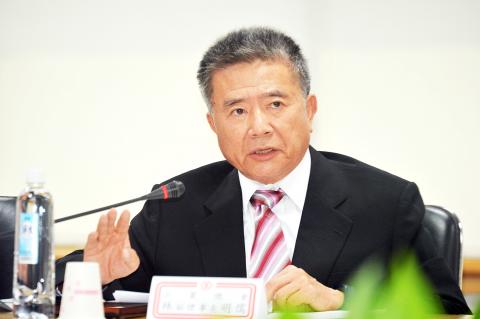Taipei Times (TT): Why is the Chinese National Federation of Industries (CNFI) worried about the government’s aim of phasing out nuclear power by 2025 to enhance safety in power generation?
Mark Lin (林明儒): Taiwan lacks energy resources and depends heavily on imports to meet 98 percent of its energy demand, with coal generating 39 percent, natural gas 35 percent and nuclear power 16 percent.
The government aims to make Taiwan nuclear-free by 2025 by raising the contribution of natural gas to 50 percent, cutting coal’s contribution to 30 percent and promoting the use of renewables such as solar, wind and hydropower, so that they should eventually make up 20 percent of the energy mix, compared with 5 percent currently.

Photo: CNA
The new energy mix requires the rapid and massive development of solar and wind energy resources and the construction of liquefied natural gas (LNG) terminals. This is a daunting task and raises uncertainty if the development slows or the construction of LNG terminals hits snags. If that were to happen, the government would have no choice but to increase power generation from coal, which would raise greenhouse gas emissions and exacerbate environmental pollution. Such a scenario would be unacceptable to the public, as well as businesses.
TT: What is wrong with the promotion of renewables to generate electricity?
Lin: Renewables supplied 4.8 percent of the nation’s energy consumption last year, and the government intends to raise their share to 9 percent in 2010 and 20 percent in 2025, when they should generate 27,423 megawatts of electricity, more than 70 percent of which would come from solar power plants.
The manufacturing industry is conservative about the development of solar power, because it requires massive land plots to build solar farms and the government has so far failed to come up with a solution to this problem.
Wind power generation at offshore facilities seems more promising, but is to cost NT$6 per kilowatt-hour (kWh) and it will take a while to overcome engineering bottlenecks. The government has installed wind power capacity in suitable coastal areas and will have difficulty finding much more space for new capacity.
Authorities have provided the private sector with strong incentives to develop renewable energy sources, all of which will translate into significantly higher electricity prices in the future. We wonder if these favorable policies will be maintained, especially in case of an economic downturn. The government might then intervene through electricity price adjustments, making renewal energy development unpopular and unprofitable.
TT: What effect will the development of renewables have on electricity rates?
Lin: On average, nuclear power costs NT$1.2 per kWh. Offshore wind power costs NT$6 per kWh and solar power between NT$5 and NT$7 per kWh.
A drastic spike in electricity bills is inevitable if firms and households are to use more renewable energy. That would push up production costs and consumer prices. Local think tanks have projected the nation’s GDP growth could drop by 0.52 to 0.72 percentage points if the government were to decommission all nuclear power plants.
Stable power supply is critical to manufacturing facilities that run 24 hours a day. Potential losses are huge.
TT: What are the CNFI’s views on the increased dependence on LNG and coal for electricity generation?
Lin: The plans to raise LNG input to 50 percent would run into difficulties, because the nation does not have enough unloading and storage capacity, and hence has a low reserve margin. Unless the government drastically expands LNG unloading and storage capacity, there will be concerns about stability of power supply and safety.
The government has commissioned state-run Taiwan Power Co (台電) to build an LNG terminal in Keelung, but has not commissioned a company to build another terminal in Taichung, showing that it is not ready to meet the tough challenges of implementing its energy policy.
We also believe the government should reconsider its energy policy direction for national security reasons. Taiwan depends heavily on imports of LNG and coal for power generation, mainly from Qatar, Malaysia, Indonesia and Australia.
China has sought to dominate the South China Sea and its chilling ties with Taiwan could evolve into a threat to stable and smooth supply. National LNG reserves would last between seven and 10 days, and coal reserves about 36 days. If supply should be disrupted, Taiwan could run out of natural gas or coal and face an electricity shortage. By comparison, nuclear fuel lasts a year-and-a-half, making it more stable and reliable.
TT: What would the federation suggest the government do with the nuclear power plants?
Lin: A nuclear-free Taiwan is not practical or urgent in light of global trends. Japan has reactivated idle nuclear power facilities with nuclear power expected to meet 20 to 22 percent of Japanese energy demand by 2030. China is contemplating increasing the use of nuclear power to cut carbon emissions and ensure sufficient power supply.
The UK has decided to build new generators with similar aims. Switzerland and Sweden, which earlier presented plans to phase out nuclear power facilities, are entertaining the possibility of a reversal.
According to international research bodies, nuclear power last year supplied 11 percent of the world’s power, but that could rise to 18 percent in 2040, as governments seek to lower carbon emissions and maintain a stable power supply.
Taiwan should follow suit, as long as authorities can guarantee a stable power supply. Electricity is fundamental and critical to a nation’s economic development. Without the support of nuclear power plants, the nation’s electricity reserve could drop below 3 percent in 2025 and power shortages could deal a blow to industrial production and economic activity.
The government should see how renewables develop before it decides on the pace of nuclear decommissioning.
TT: Would you also comment on the business outlook of Feng Hsin Steel Co (豐興鋼鐵) in the second half of the year?
Lin: Demand for steel recovered and sales prices picked up in the first half of the year and might continue to improve for the rest of the year, after China moved to cut its steel output, the main cause of the market glut.

CHIP RACE: Three years of overbroad export controls drove foreign competitors to pursue their own AI chips, and ‘cost US taxpayers billions of dollars,’ Nvidia said China has figured out the US strategy for allowing it to buy Nvidia Corp’s H200s and is rejecting the artificial intelligence (AI) chip in favor of domestically developed semiconductors, White House AI adviser David Sacks said, citing news reports. US President Donald Trump on Monday said that he would allow shipments of Nvidia’s H200 chips to China, part of an administration effort backed by Sacks to challenge Chinese tech champions such as Huawei Technologies Co (華為) by bringing US competition to their home market. On Friday, Sacks signaled that he was uncertain about whether that approach would work. “They’re rejecting our chips,” Sacks

NATIONAL SECURITY: Intel’s testing of ACM tools despite US government control ‘highlights egregious gaps in US technology protection policies,’ a former official said Chipmaker Intel Corp has tested chipmaking tools this year from a toolmaker with deep roots in China and two overseas units that were targeted by US sanctions, according to two sources with direct knowledge of the matter. Intel, which fended off calls for its CEO’s resignation from US President Donald Trump in August over his alleged ties to China, got the tools from ACM Research Inc, a Fremont, California-based producer of chipmaking equipment. Two of ACM’s units, based in Shanghai and South Korea, were among a number of firms barred last year from receiving US technology over claims they have

BARRIERS: Gudeng’s chairman said it was unlikely that the US could replicate Taiwan’s science parks in Arizona, given its strict immigration policies and cultural differences Gudeng Precision Industrial Co (家登), which supplies wafer pods to the world’s major semiconductor firms, yesterday said it is in no rush to set up production in the US due to high costs. The company supplies its customers through a warehouse in Arizona jointly operated by TSS Holdings Ltd (德鑫控股), a joint holding of Gudeng and 17 Taiwanese firms in the semiconductor supply chain, including specialty plastic compounds producer Nytex Composites Co (耐特) and automated material handling system supplier Symtek Automation Asia Co (迅得). While the company has long been exploring the feasibility of setting up production in the US to address

OPTION: Uber said it could provide higher pay for batch trips, if incentives for batching is not removed entirely, as the latter would force it to pass on the costs to consumers Uber Technologies Inc yesterday warned that proposed restrictions on batching orders and minimum wages could prompt a NT$20 delivery fee increase in Taiwan, as lower efficiency would drive up costs. Uber CEO Dara Khosrowshahi made the remarks yesterday during his visit to Taiwan. He is on a multileg trip to the region, which includes stops in South Korea and Japan. His visit coincided the release last month of the Ministry of Labor’s draft bill on the delivery sector, which aims to safeguard delivery workers’ rights and improve their welfare. The ministry set the minimum pay for local food delivery drivers at